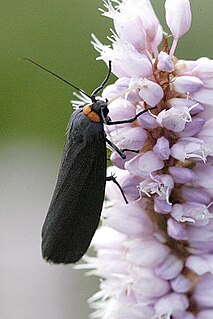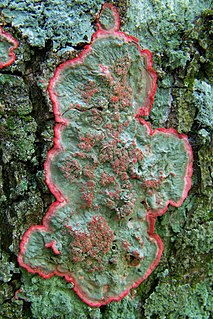
Lichenology is the branch of mycology that studies the lichens, symbiotic organisms made up of an intimate symbiotic association of a microscopic alga with a filamentous fungus.

Cladonia rangiferina, also known as reindeer lichen or grey reindeer lichen, is a light-colored, fruticose lichen belonging to the family Cladoniaceae. It grows in both hot and cold climates in well-drained, open environments. Found primarily in areas of alpine tundra, it is extremely cold-hardy.

Cladonia is a genus of moss-like lichens in the family Cladoniaceae. They are the primary food source for reindeer and caribou. Cladonia species are of economic importance to reindeer-herders, such as the Sami in Scandinavia or the Nenets in Russia. Antibiotic compounds are extracted from some species to create antibiotic cream. The light green species Cladonia stellaris is used in flower decorations.

Lichen planus (LP) is a chronic inflammatory and immune mediated disease that affects the skin, nails, hair, and mucous membranes. It is characterized by polygonal, flat-topped, violaceous papules and plaques with overlying, reticulated, fine white scale, commonly affecting dorsal hands, flexural wrists and forearms, trunk, anterior lower legs and oral mucosa. Although there is a broad clinical range of LP manifestations, the skin and oral cavity remain as the major sites of involvement. The cause is unknown, but it is thought to be the result of an autoimmune process with an unknown initial trigger. There is no cure, but many different medications and procedures have been used in efforts to control the symptoms.

Lichen sclerosus (LS) is a skin disease of unknown cause, commonly appearing as whitish patches on the genitals, which can affect any body part of any person but has a strong preference for the genitals and is also known as balanitis xerotica obliterans (BXO) when it affects the penis. Lichen sclerosus is not contagious. There is a well-documented increase of skin cancer risk in LS, potentially improvable with treatment. LS in adult age is normally incurable, but improvable with treatment, and often gets progressively worse.

Erik Acharius was a Swedish botanist who pioneered the taxonomy of lichens and is known as the "father of lichenology" and famously the last pupil of Carl Linnaeus.

Usnea is a genus of mostly pale grayish-green fruticose lichens that grow like leafless mini-shrubs or tassels anchored on bark or twigs. The genus is in the family Parmeliaceae. It grows all over the world.

In archaeology, palaeontology, and geomorphology, lichenometry is a geomorphic method of geochronologic dating that uses lichen growth to determine the age of exposed rock, based on a presumed specific rate of increase in radial size over time. Measuring the diameter of the largest lichen of a species on a rock surface can therefore be used to determine the length of time the rock has been exposed. Lichen can be preserved on old rock faces for up to 10,000 years, providing the maximum age limit of the technique, though it is most accurate when applied to surfaces that have been exposed for less than 1,000 years. Lichenometry is especially useful for dating surfaces less than 500 years old, as radiocarbon dating techniques are less accurate over this period. The lichens most commonly used for lichenometry are those of the genera Rhizocarpon and Xanthoria. The measured growth rates of R. geographicum tends to fall within the range of 0.9 - 0.3 millimeter per year, depending on several factors, including the size of the lichen patch.

Licheń Stary is a village in the administrative district of Gmina Ślesin, within Konin County, Greater Poland Voivodeship, in west-central Poland. It lies approximately 7 kilometres (4 mi) south-east of Ślesin, 14 km (9 mi) north-east of Konin, and 99 km (62 mi) east of the regional capital Poznań. The village has a population of 1,100.

Primary producers convert an abiotic source of energy into energy stored in organic compounds, which can be used by other organisms. The primary producers can convert the energy in the light or the energy in inorganic chemical compounds (chemolithotrophs) to build organic molecules, which is usually accumulated in the form of biomass and will be used as carbon and energy source by other organisms. The photoautotrophs are the main primary producers, converting the energy of the light into chemical energy through photosynthesis, ultimately building organic molecules from carbon dioxide, an inorganic carbon source. Examples of chemolithotrophs are some archaea and bacteria that produce biomass from the oxidation of inorganic chemical compounds, these organisms are called chemoautotrophs, and are frequently found in hydrothermal vents in the deep ocean. Primary producers ares at the lowest trophic level, and are the reasons why Earth is sustainable for life to this day.

Ethnolichenology is the study of the relationship between lichens and people. Lichens have and are being used for many different purposes by human cultures across the world. The most common human use of lichens is for dye, but they have also been used for medicine, food and other purposes.
Lichen spinulosus is a rare skin disorder characterized by follicular keratotic papules that are grouped into large patches. It is a variant of keratosis pilaris named for its resemblance to a patch of lichen.

The Lithosiini are a tribe of lichen moths in the family Erebidae.
Lichen nitidus is a chronic inflammatory disease of unknown cause characterized by 1–2 mm, discrete and uniform, shiny, flat-topped, pale flesh-colored or reddish-brown papules that may appear as hypopigmented against dark skin. Occasionally, minimal scaling is present or can be induced by rubbing the surface of the papules. The disease usually affects children and young adults and is painless and usually nonpruritic, although protracted itching may occur in some cases. It is sometimes referred to by dermatologists as "mini lichen planus".
An ulcer is a discontinuity or break in a bodily membrane that impedes the organ of which that membrane is a part from continuing its normal functions. According to Robins pathology, "ulcer is the breach of the continuity of skin, epithelium or mucous membrane caused by sloughing out of inflamed necrotic tissue." Common forms of ulcers recognized in medicine include:

The Arthoniales is the second largest orders of mainly crustose lichens, but fruticose lichens are present as well. The order contains around 1500 species, while the largest order with lichenized fungi, the Lecanorales, contains more than 14000 species.
"The Thief of Baghead" is the fourth episode of the seventh season of the animated sitcom Futurama. It originally aired on Comedy Central on July 4, 2012. The episode was written by series co-producer Dan Vebber and directed by Edmund Fong.

Crustose lichens form a crust that strongly adheres to the substrate, making separation from the substrate impossible without destruction. The basic structure of crustose lichens consists of a cortex layer, an algal layer, and a medulla. The upper cortex layer is differentiated and is usually pigmented. The algal layer lies beneath the cortex. The medulla fastens the lichen to the substrate and is made up of fungal hyphae. The surface of crustose lichens is characterized by branching cracks that periodically close in response to climatic variations such as alternate wetting and drying regimes.
Terete is a term used in botany to describe a cross section that is circular, or like a distorted circle, with a single surface wrapping around it. This is usually contrasted with cross-sections that are flattened, with a distinct upper surface that is different from the lower surface. The cross-section of a branch in a tree is somewhat round, so the branch is terete. The cross section of a normal leaf has an upper surface, and a lower surface, so the leaf is not terete. However, the fleshy leaves of succulents are sometimes terete. Fruticose lichens are terete, with a roughly circular cross section and a single wrap-around skin-like surface called the cortex, compared to foliose lichens and crustose lichens, which have a flattened cross section with an upper surface that is distinct from the lower surface.















